Here you can download plans for the making of 3 variants of the handy garden tool called ‘hand soil auger’. We called them: Post hole fence hand auger, Spiral garden hand auger and Universal hand soil auger.
If it is necessary to dig holes in the ground for fence posts, posts for wooden structures (pergolas, arbors, gazebos...) or tree seedlings, most commonly a spade is used for this purpose. With the spade, this job can be done easily, but you will always dig holes larger than necessary and the problem arises if the holes need to be deeper than the spade height. Sometimes this problem may not occur, but if the hole number should be large and holes need to be filled with concrete, you will have unnecessary concrete consumption. All these problems can be solved with a simple tool called ‘hand auger’, which makes digging holes in the ground easier, faster, whereby the holes are always the same size, the amount of concrete (if used) is much smaller, and the lawn around the holes remains intact. With a hand auger, you can dig deep circular holes of the same diameter, and a hand auger with a smaller diameter can even be used for planting flowers since this does not require any large holes. One of the good features is that the pole placed in the hole dug with the auger is more stable because the soil around the hole is intact, unlike the hole dug wih the spade (the deeper the hole, the larger the hole surface area).
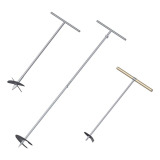
Post hole fence hand auger: Height of the auger 1366mm (53 13/16‘’), Length of the handle 600mm (23 5/8’’), Diameter 275mm (10 27/32’’)
Spiral garden hand auger: Height of the auger 2368 mm (93 7/32‘’), Length of the handle 600mm (23 5/8’’), Diameter 300mm (11 13/16’’)
Universal hand soil auger: Height of the auger 1258 mm (49 17/32‘’), Length of the handle 730mm (28 3/4’’), Diameter 203mm (8’’)
Variant 1 (Post hole fence hand auger) - This variant is made of steel sections of the square cross section, instead of which you can use steel pipes. A good feature of this hand auger is that the soil-digging thread has no helix shape, i.e., you do not have to deform the metal to get a helix. Also, the spike does not have to be deformed or made on the lathe, either.
Variant 2 (Universal hand soil auger) - We too own this kind of hand auger variant, which has proven to be very practical. The spike is easily made by cutting the initial shape, warming it to a red color and then twisting it 180 degrees with a clamp. The spike is mounted on the hand auger by deforming (flattening) the pipe at its end, inserting the spur into it and welding. The handle is made from wood, but you can also make it from a metal pipe.The auger disc for digging is obtained by cutting a 30cm diameter disc. Using an angle grinder, you cut this disc in radius and then bend one quarter of the disc. For clarification, take a look at the drawing.
Variant 3 (Spiral garden hand auger) - This auger also has an extension so you can take advantage of this extra feature. It digs holes 30cm (11 13/16in) in diameter, and the hole depth can be twice the size of the holes dug with the first two variants. The spike on this variant is made on a lathe, but if you have a problem with that, make a spike like on variant 1 or 2. The helix is obtained by cutting a circular disc, cutting the disc with an angle grinder by radius, and deforming it to produce approximately a helix with one turn, about 80mm high.It is possible to weld a ¼-turn thread end to helix (see drawing). In this case, you need to weld the helix a little farther from the end of the pipe to make room for this part. Part 10 Thread end is fixed by welding. Join between parts (4. Joint tube, 3 Extension shaft and 5. Handle tube): Drill holes 6mm in diameter in the pipe (Parts 3 and 5), insert a portion of Joint tube into the pipe (Parts 3 and 5) to protrude 60mm and fill the holes with metal by welding.
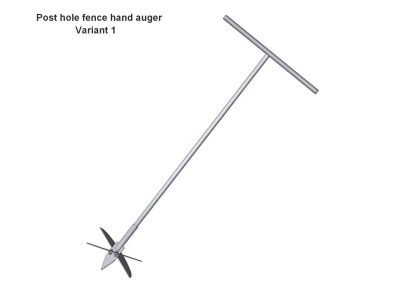
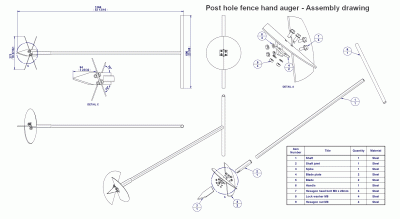
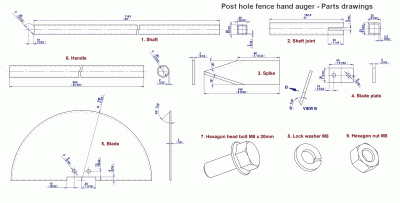
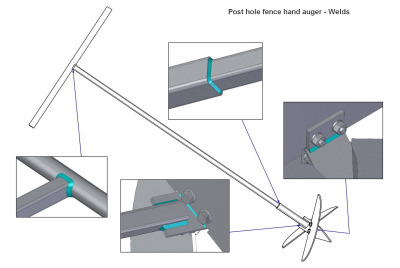
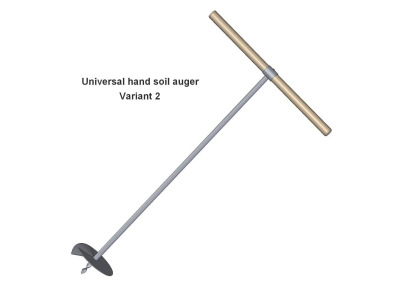
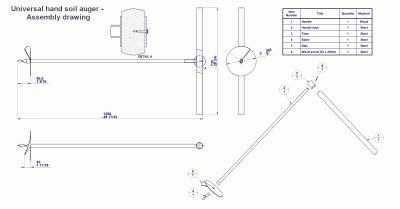
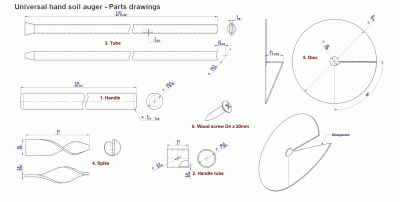
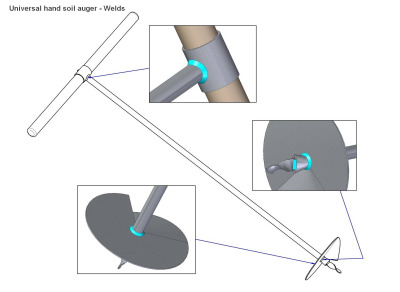
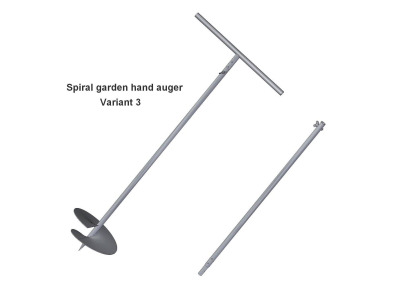
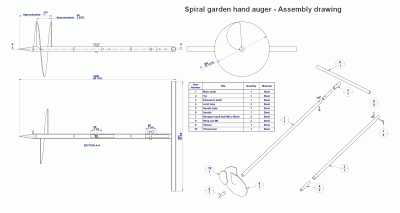
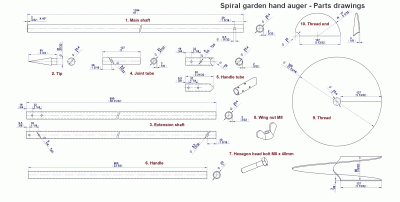
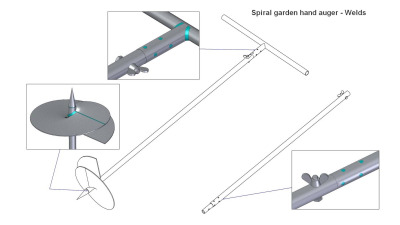
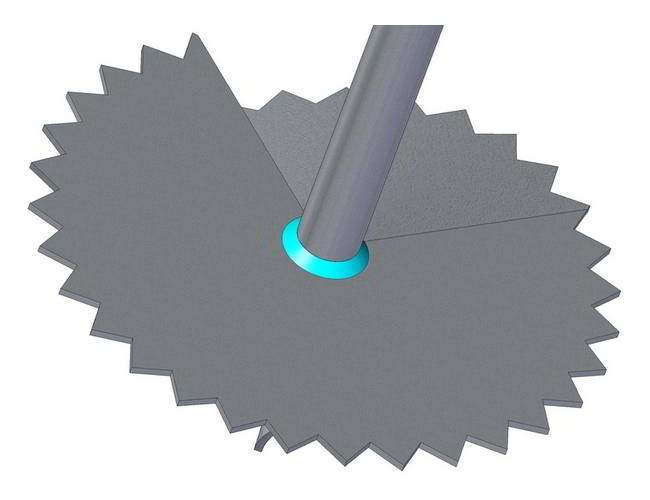
Hole digging procedure with the hand auger: Thrust the hand auger into the place where you want the hole to be. By rotating the auger and pressing down, the auger enters deeper and deeper into the ground. The soil that is dug by the auger slowly fills up the space above the disc (blade, thread...). When the space above the disc is filled up, the auger is removed and the soil spilled. It should be noted that problems can occur if there are roots and stones in the ground. The auger effectively cuts small roots, especially if the edge of the blade is sharp. If you come across thicker roots, you need to remove the auger from the hole and use branching scissors to cut the root and remove it from the hole. Another problem is the stones, bricks, and similar material in the ground. Small stones pass through the auger, but if you come across larger ones, you have to take the hand auger out of the hole and then somehow dig out from below and remove the stone using a garden spatula, for instance. Of course, if the stone is big, you have to move the hole to another place or make a big hole with a spade to be able to pull that big stone out. After use, clean the auger from soil and put it aside.
With the first and second variants, you can make notches (teeth - as with a saw) in the outer disc diameter as in the following illustration. We have seen this type of hand auger with several models in online stores. We do not know if and how much such a hand auger is more effective, but if the notches are of the correct size and sharpened, they will probably make a circular saw and cut through the ground and small roots more easily.

You can change the auger dimensions from the plans but not too much. If you increase the thread diameter considerably, you may either not have enough digging power or the auger will deform. You can use similar pipes as given in our plans, and you do not have to strictly stick to the proposed pipe dimensions. Here too you need to be careful - if you increase them a lot, the auger will be heavy, and if you reduce them too much, the auger will deform.
We have owned an auger for years (variant two), and it has been serving us really well. There are many parts of bricks and stones in the backyard ground, as well as plenty of roots. We have dug lots of holes with the auger for rose and tree seedlings, and also holes for fence posts. Sometimes it is not easy to work with it because of the problems caused by the presence of the above materials in the soil, but no matter how annoyed we get, we are constantly aware that we would get even more annoyed with working with the spade. If you need to dig a lot of holes, you are strongly recommended to choose one of these three variants and make your own hand soil auger.